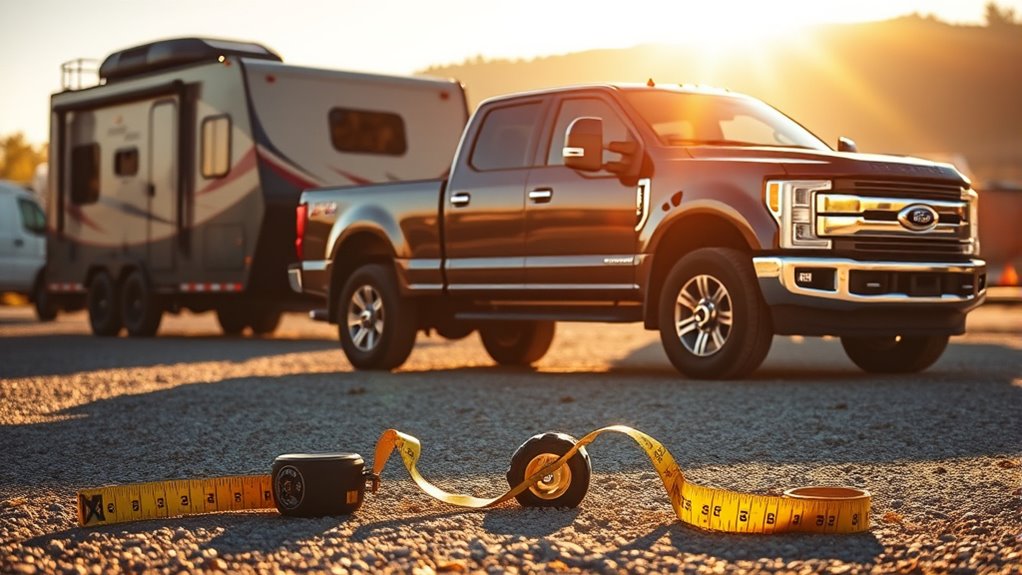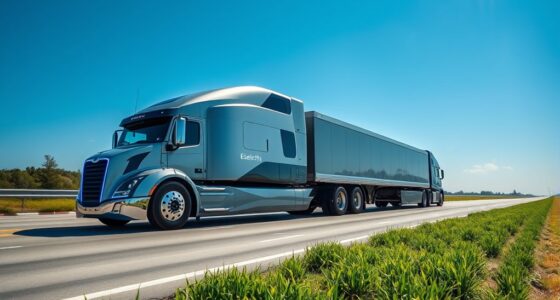When towing, it’s essential to know your vehicle’s cargo capacity, which includes passengers and cargo weight. Always check your owner’s manual for safe towing limits and hitch compatibility. Use the right type of hitch for your trailer weight, and distribute the load evenly to maintain balance. Avoid overloading to prevent handling issues and potential accidents. Understanding these basics is key to safe towing, and you’ll find more tips to enhance your towing experience ahead.
Key Takeaways
- Understand your vehicle’s cargo capacity to ensure safe towing and avoid overload situations, as detailed in the owner’s manual.
- Check hitch compatibility and select the right type, such as weight-distributing or gooseneck, based on your trailer’s weight.
- Distribute trailer weight evenly to maintain balance and prevent handling issues during towing.
- Always adhere to manufacturer guidelines for towing limits to enhance safety and prevent vehicle damage.
- Regularly inspect hitch installation and cargo loading to ensure a secure and efficient towing experience.

When you’re gearing up to tow a trailer or haul heavy loads, understanding towing and payload basics is indispensable. Knowing your vehicle’s cargo capacity and the right hitch types can make all the difference in ensuring a safe and efficient towing experience. Your vehicle’s cargo capacity refers to the total weight it can safely carry, including the weight of any passengers, cargo, and the trailer’s tongue weight. Before you hit the road, it’s crucial to check your owner’s manual or the manufacturer’s specifications to find this important information.
Understanding your vehicle’s cargo capacity and selecting the right hitch type are essential for safe towing.
Next, you’ll want to consider the hitch types available for your vehicle. Different hitches are designed for different towing capacities, so choosing the right one is essential. There are several common hitch types, including weight-carrying hitches, weight-distributing hitches, gooseneck hitches, and fifth-wheel hitches. Each has its own strengths and weaknesses, depending on what you plan to tow.
For instance, weight-carrying hitches are typically used for lighter loads and attach directly to the rear of your vehicle. If you’re towing a heavier trailer, though, a weight-distributing hitch might be more suitable. This type redistributes the trailer weight across all axles, giving you better control and stability on the road. On the other hand, if you’re looking to haul a large fifth-wheel trailer or a gooseneck trailer, you’ll need a compatible hitch designed specifically for that purpose.
Once you’ve determined your vehicle’s cargo capacity and selected an appropriate hitch type, it’s time to load up. Make sure the weight is evenly distributed in your trailer to maintain balance while driving. Overloading your vehicle or trailer can lead to dangerous situations, including poor handling and increased wear on your vehicle. Additionally, understanding the importance of cargo capacity can help prevent accidents during your towing journey.
To sum it up, understanding towing and payload basics isn’t just about knowing how much weight you can pull; it’s about ensuring you have the right equipment and knowledge to do it safely. Double-check your cargo capacity, select the right hitch type, and load evenly to keep your towing experience smooth and worry-free. With these fundamentals in mind, you’ll be well-equipped for your next adventure on the road.
Frequently Asked Questions
How Do I Calculate My Vehicle’s Towing Capacity?
To calculate your vehicle’s towing capacity, start by checking your owner’s manual for its Gross Vehicle Weight Rating (GVWR). Subtract your vehicle’s curb weight from this rating to find the maximum load you can tow. Keep in mind that the total weight of your trailer and cargo shouldn’t surpass this towing capacity. Always consider factors like passengers and gear in your vehicle weight to ensure safe towing.
Can I Tow With a Vehicle Not Rated for Towing?
You shouldn’t tow with a vehicle not rated for towing. Doing so can compromise towing safety, risking damage to your vehicle and possibly causing accidents. While some might consider vehicle modifications to enhance towing capacity, these changes often don’t meet safety standards or manufacturer guidelines. It’s best to stick with a vehicle designed for towing to guarantee safety for you and others on the road. Always prioritize safety over convenience.
What Accessories Improve Towing Performance?
To boost your towing performance, consider essential trailer accessories. A reliable weight distribution hitch enhances stability, while sway control systems safeguard against swaying. Don’t forget brake controllers for towing safety, guaranteeing smooth stops. Upgraded mirrors expand your view, making maneuvering easier. Additionally, investing in a heavy-duty ball mount ensures strength and security. By equipping your vehicle with these accessories, you’ll enhance overall towing capability and enjoy a safer, smoother journey.
How Does Altitude Affect Towing Capabilities?
Altitude impacts your towing capabilities by reducing engine power and affecting your vehicle’s performance. As you climb to higher elevations, the thinner air means your engine has to work harder to maintain performance, which can lead to lower towing capacity. You’ll need to make towing adjustments, like decreasing your load or improving your vehicle’s cooling system, to guarantee safe and efficient towing in those higher altitudes.
Are There Specific Tire Requirements for Towing?
Yes, there are specific tire requirements for towing. You need to pay attention to tire size and make certain you’ve got the right pressure for your load. Under-inflated tires can lead to blowouts, while over-inflated tires may cause uneven wear. Always check the manufacturer’s recommendations for tire pressure when towing. It’s vital to have tires rated for the weight you’re hauling to maintain safety and performance on the road.
Conclusion
Understanding towing and payload is like learning to dance; once you get the rhythm, it all flows smoothly. By knowing your vehicle’s limits and choosing the right equipment, you can tackle any hauling task with confidence. Remember to check your weights, distribute loads evenly, and always prioritize safety. With these basics in mind, you’ll be ready to hit the road and handle whatever challenges come your way, ensuring a smooth journey for you and your cargo.









